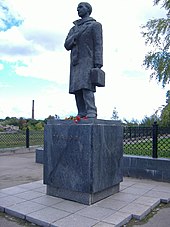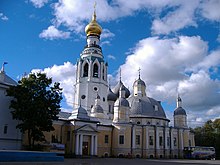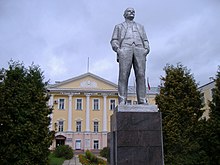Vologda
| city
Vologda
Вологда
|
|||||||||||||||||||||||||||||||||||||||||||
|
|||||||||||||||||||||||||||||||||||||||||||
|
|||||||||||||||||||||||||||||||||||||||||||
| List of cities in Russia | |||||||||||||||||||||||||||||||||||||||||||
The city of Vologda ( Russian Во́логда ) is the regional capital of the Vologda Oblast on the river of the same name . It is a good 400 km as the crow flies north-northeast of the Russian capital Moscow and has 301,755 inhabitants (as of October 14, 2010).
history
The area was probably settled before the last Ice Age , around 25,000 years ago. Archaeologists found evidence from the older Stone Age .
Finnish tribes immigrated to the area about 2000 years ago. Today, however, only about 6000 members of the Wepsen people live in the northwest of the area and in the adjacent administrative units.
Slavic colonization of the area began in the 5th century , and the first cities, namely Belozersk , Vologda and Veliki Ustyug , were probably built in the 8th century . Belozersk as the oldest documented city was first mentioned in 862, only a little later than Novgorod .
In the 11th and 12th centuries which reached Christianity the area after it in since 988 Kiev was the state religion. The city of Vologda was first mentioned in a chronicle in 1147. From the 13th century onward, missionary activity began in Vologda. At that time, many monasteries were built, especially in the north of Russia (including the Kirillo-Belozersky monastery , the largest in Russia), in the hope of converting the non-Slavic population to Christianity.
At that time, the area was not yet under the rule of Vologda, rather Belozersk (then still Belo Osero) was the center of the principality of the same name in the northern Russian border region. During the Middle Ages and afterwards, Vologda, like Belosersk, Totma and Kirillow, maintained lively trade contacts with the Hanseatic League . The Lübeck bell from 1687, cast by Albert Benningk and located in the bell tower of the Vologder Kremlin, is a testimony to this period .
In the middle of the 15th century, Prince Vasily II ( Ivan III's father ) had to flee to Vologda. Here he rebuilt his army and retook Moscow. Under Ivan the Terrible there were plans to make Vologda the capital. As a result of these considerations, the city experienced an upswing and was generously expanded. Ivan appreciated the quiet of the city and its convenient location on the way to the newly founded Arkhangelsk . During his reign the English , Dutch and Danes received concessions for ore and salt mining. The European merchants resided mainly in Veliky Ustyug.
During the time of turmoil (1598–1613), the city was conquered and devastated by the troops of Polish interventions, many of its inhabitants were killed. In the further course of the 17th century, however, the city was able to recover well under the rule of the new Romanov dynasty and rose to become the third largest Russian city after Moscow and Yaroslavl until the establishment of Saint Petersburg . After the founding of Saint Petersburg by Peter the Great , Vologda's importance gradually declined again, as the Arkhangelsk trade route, to which Vologda owed much of its prosperity, fell behind in the period that followed.
In the city there was the POW camp 158 for German prisoners of war of the Second World War . The prisoner-of-war hospital 5091 in Tscherepowez and the prisoner-of-war hospital 3732 in Woschega, 170 km to the north, were assigned to the camp .
Population development
| year | Residents | year | Residents |
|---|---|---|---|
| 1825 | 9,699 | 1959 | 139.137 |
| 1856 | 14,159 | 1970 | 177.751 |
| 1897 | 27,705 | 1979 | 236,537 |
| 1917 | 69,664 | 1989 | 282,802 |
| 1926 | 57,976 | 2002 | 293,046 |
| 1939 | 95.314 | 2010 | 301,755 |
Note : 1897, 1926-2010 census data
Geography and climate
The oblast belongs to the northern administrative region of Russia and consists mainly of flat land with loamy soils. 70 percent of the area is covered by forests, another 12 percent are swamps and moorlands. Only 11 percent can be used for agriculture.
The climate is cool temperate continental , the average temperatures are -13 ° C in January and +17 ° C in July. Annual precipitation is 561 mm. Vologda is 118 meters above sea level.
The largest river in the area is the Suchona , another, more important waterway is the Volga-Onega Canal, which follows the course of the Šeksna in the west of the area and ends at Cherepovets in the Rybinsk Reservoir . This Wolgastausee (4580 km²) and the Onegasee in the northwest (9610 km²) are the largest lakes in the area.
| Vologda | ||||||||||||||||||||||||||||||||||||||||||||||||
|---|---|---|---|---|---|---|---|---|---|---|---|---|---|---|---|---|---|---|---|---|---|---|---|---|---|---|---|---|---|---|---|---|---|---|---|---|---|---|---|---|---|---|---|---|---|---|---|---|
| Climate diagram | ||||||||||||||||||||||||||||||||||||||||||||||||
| ||||||||||||||||||||||||||||||||||||||||||||||||
|
Average monthly temperatures and rainfall for Vologda
Source: Roshydromet
|
|||||||||||||||||||||||||||||||||||||||||||||||||||||||||||||||||||||||||||||||||||||||||||||||||||||||||
economy
The most important pillars of the economy today are various branches of machine, vehicle and device construction (cranes, agricultural machines, railway equipment, buses, electrical and optical devices). also metal processing, black metallurgy, chemical industry and wood processing and paper industry. Byvalovsky mashinostroitelny zavod is one of the most important engineering companies in the Russian northwest region.
The city has several theaters, libraries and museums as well as a wide range of universities.
traffic
Vologda is connected to the Russian capital Moscow via the M8 Kholmogory trunk road . At the same time, the city is the starting point of the R298 , which leads west to Novaya Ladoga near Saint Petersburg .
Further educational institutions
- Vologda State Dairy Academy Vologda
- Vologda State Technical University, founded in 1966, around 12,000 students
- Vologda State Pedagogical University
- Institute of the Ministry of Justice for Law and Economics
- Branch of the Moscow State Legal Academy
- Branch of the A. S. Gribojedow Institute for International Law and Economics
- Branch of the Metropolitan Humanities Institute
Museums
- Historical, architectural and art history museum reserve Vologda:
- Vologda Kremlin
- St. Sophia Cathedral
- Bell tower of St. Sophia Cathedral
- House of Peter I.
- Vologda Oblast Museum of Architecture and Ethnology in Semjonkowo
- Museum "The World of Forgotten Things"
- Museum "The Merchant Samarin's House"
- Museum of the Diplomatic Corps
- Vologda Picture Gallery:
- Central exhibition hall
- Shalamov House
sons and daughters of the town

- Pyotr Rytschkow (1712–1777), historian and geographer
- Konstantin Batjuschkow (1787–1855), poet
- Christofor Ledenzow (1842–1907), merchant and patron
- Grigori Landsberg (1890–1957), physicist
- Varlam Shalamov (1907–1982), writer
- Vladimir Morozov (1910–1975), mathematician
- Dmitri Gudkow (1918–1992), mathematician
- Natalija Prosorowa (1922–2006), law scholar and university professor
- Valery Gavrilin (1939–1999), composer
- Oleg Grigoryev (1943–1992), writer and painter
- Igor Polovodin (1955-2005), chess player and trainer
- Swetlana Djomina (* 1961), sports shooter
- Nikolai Guljajew (* 1966), speed skater
- Vladislav Solodyagin (* 1975), opera singer (bass)
- Anya Monzikova (* 1984), Russian-American actress and model
- Julija Chekaljowa (* 1984), cross-country skier
- Ivan Kassutin (* 1986), ice hockey goalkeeper
- Irina Leuchina (* 1987), biathlete
Town twinning
Vologda lists the following twin cities :
-
 Londonderry , New Hampshire , United States
Londonderry , New Hampshire , United States
-
 Miskolc , Hungary
Miskolc , Hungary
-
 Zwolle , Netherlands
Zwolle , Netherlands
-
 Kouvola , Finland
Kouvola , Finland
photos
Web links
- Official website of the city of Vologda (Russian / English)
Individual evidence
- ↑ a b Itogi Vserossijskoj perepisi naselenija 2010 goda. Tom 1. Čislennostʹ i razmeščenie naselenija (Results of the All-Russian Census 2010. Volume 1. Number and distribution of the population). Tables 5 , pp. 12-209; 11 , pp. 312–979 (download from the website of the Federal Service for State Statistics of the Russian Federation)
- ↑ Maschke, Erich (Ed.): On the history of the German prisoners of war of the Second World War. Verlag Ernst and Werner Gieseking, Bielefeld 1962–1977.









